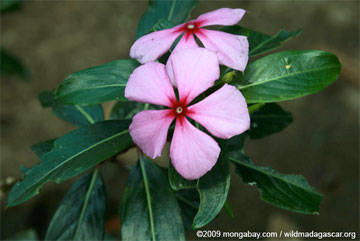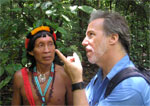If someone saves your life, you want to express your gratitude however you can — a gesture, a “thank you,”, or somehow returning the favor. Yet when you owe your life to a plant found thousands of miles away, the task becomes much harder.
As a nurse, I’ve known for years that many life-saving medicines come from plants and animals found around the world. But I never thought that one day I would have to rely on the bark of a rare Asian tree to survive.
Nine years ago, I was diagnosed with appendiceal cancer and told that I had only months to live. The mother of two young children at the time, I could not accept the prognosis. Luckily, I found a doctor who was willing to help me fight. I had major abdominal surgery and months of chemotherapy.
Today I am cancer free, in large part because of irinotecan. A drug that helps block the growth of cancer cells, irinotecan is derived from a tree with banana-shaped pods found only in China and Tibet and aptly called the “Chinese Happy Tree.” Yet, this tree and many other potential sources of future treatments are endangered and could soon be gone forever.
I have lived many years past my life expectancy. And countless others are alive and healthy today because of other medicines — from those that help lower cholesterol to those used to fight malaria — originally derived from natural sources.
Across the globe, however, many of our remaining wild areas that shelter plants and animals that could be the future source of numerous other new drugs, are quickly disappearing. The razing of a forest in what seems like a remote corner of the world could have life-or-death consequences for people here in the United States.
Plants can’t move to escape harm, so they use a complex chemical arsenal to protect themselves from insects, diseases, and other threats. And many of these compounds have the potential to protect not only plants, but us as well. Indeed, half of all of the new drugs developed in the past 25 years, and 70 percent of the drugs currently used to treat cancer, have been derived from nature.
 Rosy periwinkle in Madagascar. Photo by Rhett A. Butler 2009 |
To create the new HIV drug, prostratin, scientists extracted chemical compounds from a tropical plant found in Western Samoa. The drugs vinblastine and vincristine, which treat leukemia and lymphoma, are derived from the rosy periwinkle, native to Madagascar, and there are hundreds of other examples.
Medicines have also been obtained from many animal species, some on the verge of extinction. The diabetes drug exenatide (more commonly known by its brand name “Byetta”), for example, was synthesized from a compound found in the saliva of the gila monster, an endangered lizard native to Mexico. Heart transplant survivors often take isinopril, which was derived from the venom of the Brazilian pit viper.
In 40 years, however, the habitats of these plants and animals may be gone. We lose 32 million acres of forests each year — an area almost the size of Louisiana. Scientists estimate that two-thirds of all species could become severely endangered by the end of this century. Yet researchers have only had the opportunity to test 1 percent of rainforest plants for organic compounds that could benefit human health. If we don’t act soon, natural sources that could cure cancer, arthritis, HIV, diabetes, heart disease and innumerable other illnesses, may be lost to us forever.
Most of the planet’s species live in the world’s poorest nations and that’s why I travelled, along with other cancer survivors from around the nation, to Washington last month to support a new effort in Congress to strengthen our nation’s international conservation efforts. Introduced earlier this spring, the Global Conservation Act would establish a national strategy that will help our government assist in preserving the natural areas of developing countries that are too poor to do so on their own.
I’m grateful for the Chinese Happy Tree, which helped save my life and allowed me to watch my two daughters grow up. Speaking out for nature and all the medical treatments that come from it is just my way of saying “thank you.”
Carolyn Langlie-Lesnik is a registered nurse, a nine-year survivor of appendiceal cancer and editor of the “The Appendix Cancer Connection“. A resident of Crown Park, Indiana, she works with cancer survivors to promote the links between international conservation and treating deadly diseases.)
Related articles
How rainforest shamans treat disease

(11/10/2009) Ethnobotanists, people who study the relationship between plants and people, have long documented the extensive use of medicinal plants by indigenous shamans in places around the world, including the Amazon. But few have reported on the actual process by which traditional healers diagnose and treat disease. A new paper, published in the Journal of Ethnobiology and Ethnomedicine, moves beyond the cataloging of plant use to examine the diseases and conditions treated in two indigenous villages deep in the rainforests of Suriname. The research, which based on data on more than 20,000 patient visits to traditional clinics over a four-year period, finds that shamans in the Trio tribe have a complex understanding of disease concepts, one that is comparable to Western medical science. Trio medicine men recognize at least 75 distinct disease conditions—ranging from common ailments like fever [këike] to specific and rare medical conditions like Bell’s palsy [ehpijanejan] and distinguish between old (endemic) and new (introduced since contact with the outside world) illnesses. In an interview with mongabay.com, Lead author Christopher Herndon, currently a reproductive medicine physician at the University of California, San Francisco, says the findings are a testament to the under-appreciated healing prowess of indigenous shaman.
Research into drugs derived from natural products declining
(07/09/2009) Although the majority of drugs available today have been derived from natural products, research into nature-based pharmaceuticals has declined in recent years due to high development costs and the drug approvals process. However this trend is likely to reverse due to new approaches and technologies, according researchers from the University of Alberta.
(06/29/2009) Two drugs derived from rainforest plants in Sarawk (Malaysian Borneo) are now in their final stages of development, reports Bernama.
Colorful insects help search for anti-cancer drugs
(07/07/2008) Brightly-colored beetles or caterpillars feeding on a tropical plant may signal the presence of chemical compounds active against cancer and parasitic diseases, report researchers writing in the journal Frontiers in Ecology and the Environment. The discovery could help speed drug discovery.
70% of new drugs come from Mother Nature
(03/20/2007) Around 70 percent of all new drugs introduced in the United States in the past 25 years have been derived from natural products reports a study published in the March 23 issue of the Journal of Natural Products. The findings show that despite increasingly sophisticated techniques to design medications in the lab, Mother Nature is still the best drug designer.
Indians are key to rainforest conservation efforts says renowned ethnobotanist

(10/31/2006) Tropical rainforests house hundreds of thousands of species of plants, many of which hold promise for their compounds which can be used to ward off pests and fight human disease. No one understands the secrets of these plants better than indigenous shamans -medicine men and women – who have developed boundless knowledge of this library of flora for curing everything from foot rot to diabetes. But like the forests themselves, the knowledge of these botanical wizards is fast-disappearing due to deforestation and profound cultural transformation among younger generations. The combined loss of this knowledge and these forests irreplaceably impoverishes the world of cultural and biological diversity. Dr. Mark Plotkin, President of the non-profit Amazon conservation Team, is working to stop this fate by partnering with indigenous people to conserve biodiversity, health, and culture in South American rainforests. Plotkin, a renowned ethnobotanist and accomplished author (Tales of a Shaman’s Apprentice, Medicine Quest) who was named one of Time Magazine’s environmental “Hero for the Planet,” has spent parts of the past 25 years living and working with shamans in Latin America. Through his experiences, Plotkin has concluded that conservation and the well-being of indigenous people are intrinsically linked — in forests inhabited by indigenous populations, you can’t have one without the other. Plotkin believes that existing conservation initiatives would be better-served by having more integration between indigenous populations and other forest preservation efforts.